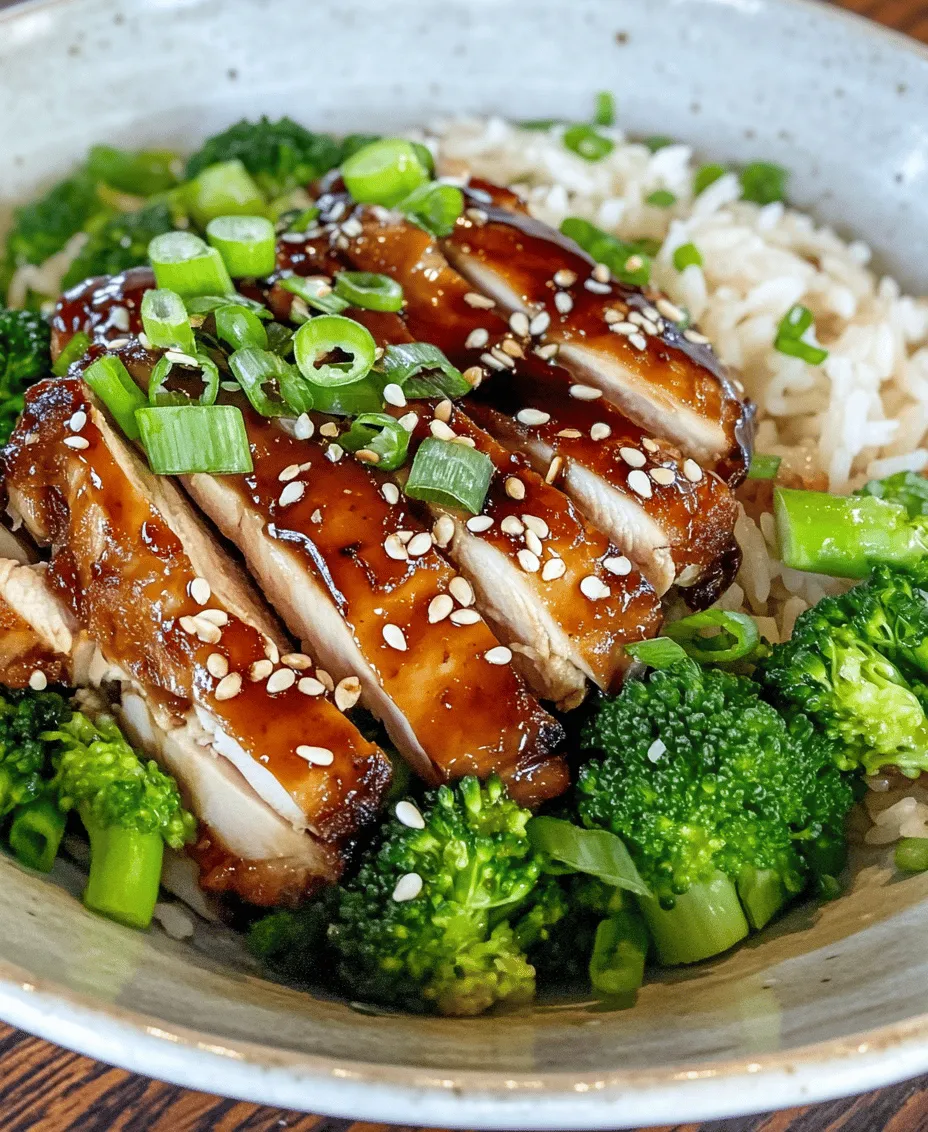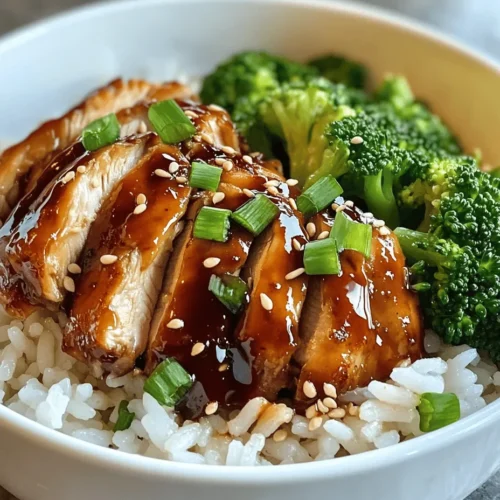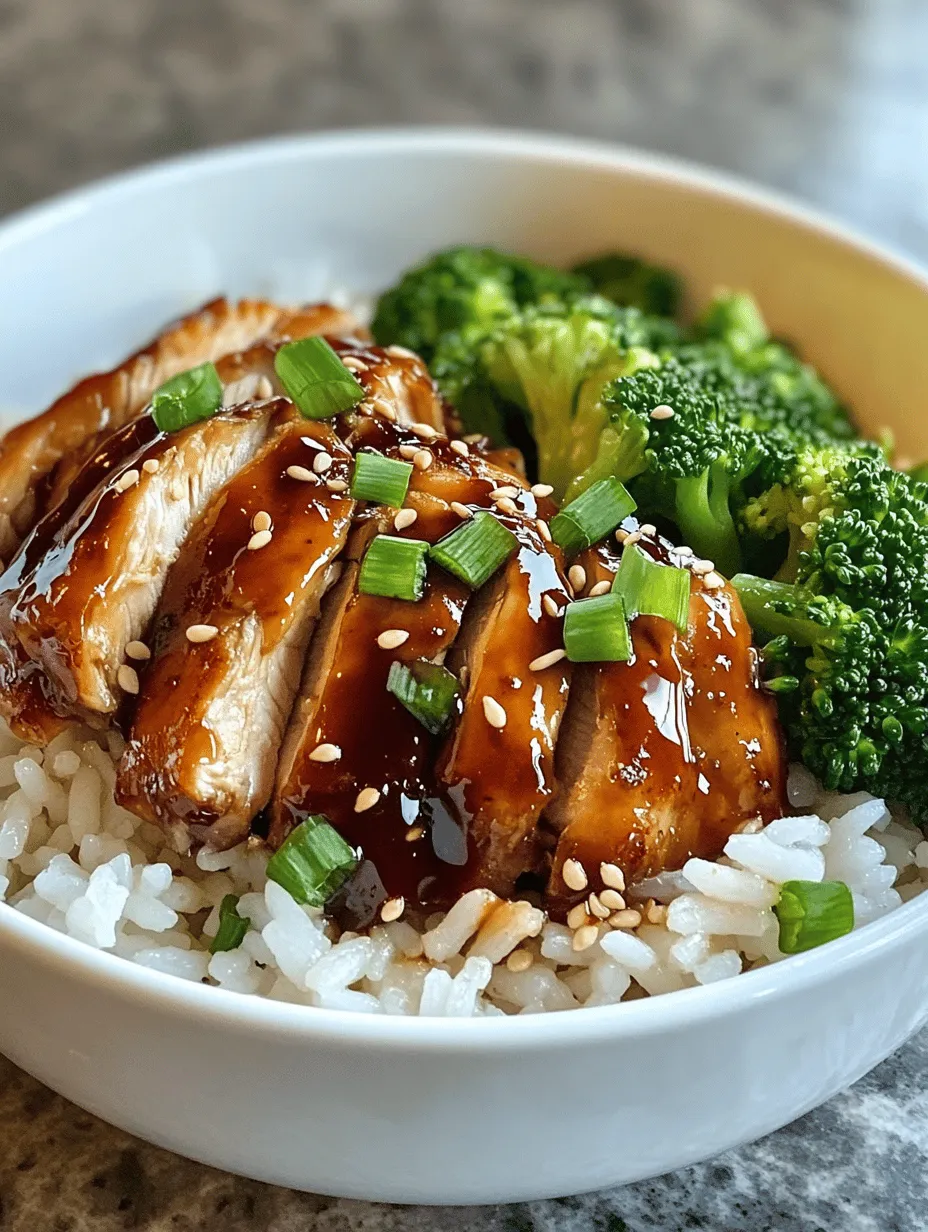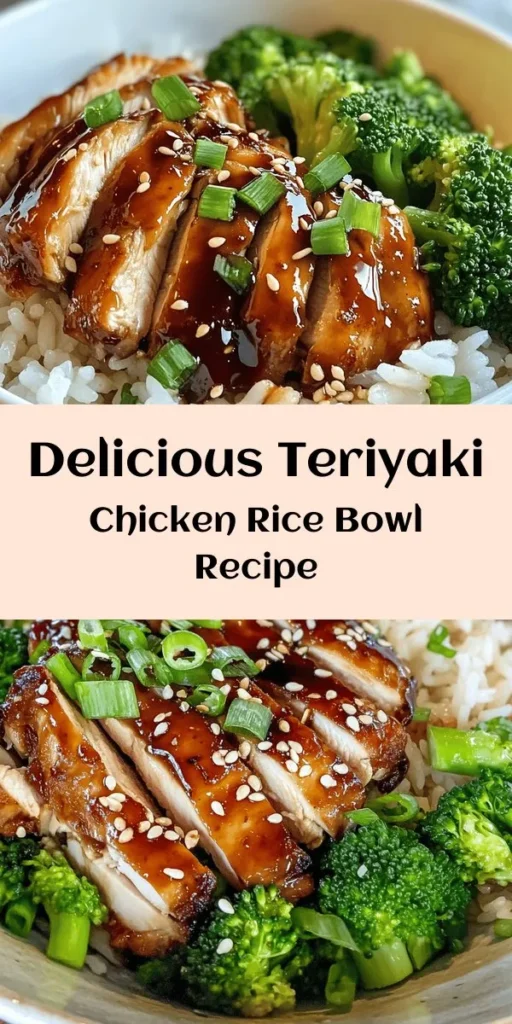Introduction
The Teriyaki Chicken Rice Bowl is a beloved dish that has made its way into kitchens around the world, celebrated for its simplicity and vibrant flavors. This Asian-inspired meal combines tender, juicy chicken coated in a savory-sweet teriyaki sauce, served over a bed of fluffy rice and complemented by fresh vegetables. Its appeal lies in the ease of preparation, making it an attractive option for busy weeknights or casual gatherings.
Not only is this dish delicious, but it also boasts a well-rounded nutritional profile. With a perfect balance of protein from the chicken, carbohydrates from the rice, and an array of vitamins and minerals from the vegetables, the Teriyaki Chicken Rice Bowl is a wholesome meal that can be customized to suit your taste preferences. Whether you prefer more vegetables, a spicier kick, or a different protein source, the versatility of this dish allows you to create a version that is uniquely yours.
Understanding Teriyaki Sauce
To truly appreciate the Teriyaki Chicken Rice Bowl, it’s essential to understand its star ingredient: teriyaki sauce. Originating from Japan, the term “teriyaki” refers to the cooking technique of grilling or broiling food with a glaze. The sauce itself is a harmonious blend of soy sauce, sake or mirin, and sugar, which imparts a sweet and savory flavor profile that enhances the taste of the chicken.
The key ingredients in teriyaki sauce include:
1. Soy Sauce: This fermented sauce made from soybeans contributes a salty, umami flavor that forms the foundation of teriyaki.
2. Mirin: A sweet rice wine, mirin adds depth and sweetness. It also helps to tenderize the meat.
3. Sugar: Brown sugar or white sugar is often added to enhance the sweetness and create a glossy finish when the sauce is cooked.
Culturally, teriyaki holds a significant place in Japanese cuisine, often enjoyed in both home cooking and in restaurants. Over time, it has transcended its traditional roots, becoming popular in various global cuisines, including American and fusion dishes.
Choosing the Right Ingredients
Creating an outstanding Teriyaki Chicken Rice Bowl begins with selecting high-quality ingredients. Here’s a closer look at the essential components you’ll need for this dish:
1. Chicken: While you can use any cut of chicken, chicken thighs are recommended for their rich flavor and tender texture. They remain juicy even after cooking, making them ideal for this dish. If you prefer a leaner option, chicken breast can also be used, but be careful not to overcook it to avoid dryness.
2. Soy Sauce: The quality of soy sauce is crucial for achieving authentic flavor. Opt for a good-quality, naturally brewed soy sauce for the best results. Look for options that are labeled “low sodium” if you’re watching your salt intake.
3. Mirin: Authentic mirin can be found in Asian grocery stores, but if you can’t find it, a mixture of sake and sugar can serve as a substitute.
4. Vegetables: Fresh vegetables not only add color and crunch but also boost the nutritional value of your dish. Common choices include bell peppers, broccoli, snap peas, and carrots. Each brings its unique flavor and health benefits, contributing vitamins and minerals essential for a balanced meal.
5. Jasmine Rice: This long-grain rice is fragrant and slightly sticky, making it a perfect base for your Teriyaki Chicken Rice Bowl. The rice’s subtle sweetness pairs well with the savory teriyaki sauce.
Step-by-Step Preparation of the Teriyaki Chicken Rice Bowl
Preparing the Jasmine Rice
The first step to a delicious Teriyaki Chicken Rice Bowl is preparing the jasmine rice. Properly cooked rice is key to achieving the right texture and flavor balance in this dish.
1. Rinsing the Rice: Begin by measuring out your jasmine rice. A common ratio is 1 cup of rice to 1.5 cups of water, but this may vary slightly based on the specific brand and your desired texture. Rinse the rice under cold water in a fine-mesh strainer to remove excess starch. This step helps prevent the rice from becoming gummy and ensures each grain remains separate and fluffy.
2. Cooking the Rice: Once rinsed, transfer the rice to a pot and add the appropriate amount of water. Bring the water to a boil over medium-high heat. Once boiling, reduce the heat to low, cover the pot with a tight-fitting lid, and let it simmer for about 15 minutes. Avoid lifting the lid during cooking, as this can disrupt the steaming process. After 15 minutes, turn off the heat and allow the rice to sit, covered, for an additional 10 minutes. This resting period helps the rice finish cooking and absorb any remaining moisture.
3. Fluffing the Rice: After resting, use a fork to gently fluff the rice, separating the grains. This step is crucial for achieving that light, airy texture perfect for your rice bowl.
Marinating the Chicken
While the rice is cooking, you can focus on marinating the chicken. This process is essential for infusing the chicken with the rich flavors of the teriyaki sauce and ensuring it remains tender during cooking.
1. Preparing the Marinade: In a medium bowl, combine soy sauce, mirin, and sugar. Mix until the sugar is fully dissolved. Optionally, you can add minced garlic and grated ginger to enhance the flavor profile. These aromatic ingredients bring an extra layer of depth to the dish.
2. Marinating the Chicken: Place your chicken thighs in a resealable plastic bag or a shallow dish, and pour the marinade over the top. Ensure that all pieces are evenly coated. Seal the bag or cover the dish, and refrigerate for at least 30 minutes, though marinating for a few hours or overnight will yield even more flavorful results.
3. Cooking the Chicken: When you’re ready to cook, remove the chicken from the marinade, allowing excess liquid to drip off. In a hot skillet or grill pan, cook the chicken over medium-high heat, typically about 6-7 minutes per side, until cooked through and the internal temperature reaches 165°F (75°C). You can also baste the chicken with the reserved marinade during cooking to enhance the flavor further.
This detailed preparation sets the stage for a delicious Teriyaki Chicken Rice Bowl that is sure to impress family and friends alike. In the next part of this article, we will explore how to assemble the bowl, add vegetables, and serve your dish with style and flair.

Techniques for Achieving a Golden-Brown Exterior and Juicy Interior
To create the perfect teriyaki chicken for your rice bowl, mastering the cooking technique is essential. The goal is to achieve a deliciously golden-brown exterior while ensuring that the interior remains juicy and tender. Here are some key techniques to help you accomplish just that:
1. Marinating: Start by marinating the chicken for at least 30 minutes. This not only infuses the meat with flavor but also helps to tenderize it. For best results, marinate for a few hours or overnight.
2. Pat Dry: Before cooking, remove the chicken from the marinade and pat it dry with paper towels. Excess moisture on the surface can prevent browning. Drying the chicken will help create that coveted golden crust.
3. High Heat Cooking: Cook the chicken over medium-high to high heat. This allows for searing, which is essential for caramelization. You can use a grill, grill pan, or skillet.
4. Avoid Crowding the Pan: If you’re cooking multiple pieces of chicken, ensure they have enough space in the pan. Overcrowding can lead to steaming rather than browning. If necessary, cook in batches.
5. Basting: As the chicken cooks, brush it with the reserved marinade for added flavor. This technique not only enhances the taste but also helps achieve a beautiful glaze.
6. Resting: After cooking, let the chicken rest for about 5-10 minutes before slicing. This allows the juices to redistribute, resulting in a juicier bite.
Importance of Cooking Chicken to the Correct Internal Temperature for Safety
When preparing chicken, ensuring it reaches the correct internal temperature is crucial for food safety. The USDA recommends cooking chicken to an internal temperature of 165°F (75°C). Use a meat thermometer to check the temperature at the thickest part of the chicken. Cooking to this temperature not only eliminates harmful bacteria but also guarantees that the chicken is fully cooked and safe to eat.
Glazing the Chicken
To enhance the flavor and appearance of your teriyaki chicken, glazing is an important step. Here’s how to create a rich teriyaki glaze:
1. Reserve Some Marinade: Before marinating the chicken, set aside a portion of the marinade in a separate bowl. This will be used for glazing the chicken during the cooking process.
2. Simmer the Marinade: After the chicken is cooked, pour the reserved marinade into a saucepan and bring it to a boil. This step is crucial as it kills any bacteria from the raw chicken.
3. Thicken the Sauce: To achieve the desired consistency, let the marinade simmer until it reduces and thickens. You can add a cornstarch slurry (one tablespoon of cornstarch mixed with two tablespoons of water) if you prefer a thicker glaze.
4. Glaze the Chicken: Brush the thickened sauce over the chicken during the last few minutes of cooking. This allows the glaze to caramelize slightly, creating a shiny, appetizing finish.
Steps to Create a Rich Teriyaki Glaze with the Reserved Marinade
1. Prepare the Marinade: Combine soy sauce, mirin, sake, brown sugar, ginger, and garlic in a bowl. Marinate the chicken for 30 minutes to overnight, reserving some sauce for later.
2. Cook the Chicken: Sear the marinated chicken in a hot skillet or on a grill until it reaches the proper internal temperature.
3. Boil the Reserved Marinade: Pour the reserved marinade into a saucepan. Bring it to a boil and let it simmer for about 5-10 minutes, or until it thickens.
4. Glaze the Chicken: Brush the thickened glaze over the chicken in the last few minutes of cooking, allowing it to caramelize slightly.
5. Serve: Slice the chicken and serve over rice, drizzling additional glaze over the top if desired.
Tips on Achieving the Right Consistency for the Sauce
To achieve a perfect teriyaki glaze, consider the following tips:
– Simmering Time: Allow the sauce to simmer long enough to concentrate the flavors and thicken. Keep in mind that it will thicken further as it cools.
– Cornstarch Slurry: If you prefer a thicker sauce, mix cornstarch with cold water to create a slurry. Stir this into the boiling marinade and cook until thickened.
– Taste Test: Always taste the glaze before serving. Adjust sweetness, saltiness, or acidity by adding more sugar, soy sauce, or vinegar as needed.
Assembling the Bowl
Once your teriyaki chicken is ready, it’s time to assemble your rice bowl for a delightful presentation. Follow these steps to create a visually appealing dish:
1. Choose Your Base: Start with a serving of rice. Traditional Japanese rice, jasmine rice, or brown rice are excellent options.
2. Layer the Ingredients: Place the sliced teriyaki chicken on top of the rice. This allows the flavors from the chicken to seep into the rice.
3. Add Vegetables: Include a variety of colorful vegetables. Steamed broccoli, sautéed bell peppers, shredded carrots, and snap peas not only add nutrition but also create a vibrant look.
4. Garnish: Top your rice bowl with fresh herbs like green onions or cilantro for an extra pop of color and flavor. Additionally, sesame seeds can add a nice crunch.
5. Drizzle with Sauce: Finish by drizzling additional teriyaki glaze over the entire bowl for added flavor and to tie all the components together.
Visual Presentation Ideas for a Delightful Serving
Presentation can elevate your meal, making it more enticing. Here are some ideas:
– Bowl Choice: Use a contrasting bowl color that allows the vibrant ingredients to stand out. A white bowl can make the colors pop.
– Layering: Consider layering the ingredients rather than mixing them. This not only looks appealing but also allows diners to appreciate each component.
– Color Contrast: Use colorful vegetables to create visual interest. Bright green broccoli, orange carrots, and red bell peppers can create a stunning bowl.
– Edible Flowers: For a gourmet touch, consider adding edible flowers as a garnish. They add a pop of color and elegance.
Suggestions for Customizing the Bowl with Various Toppings and Sides
The teriyaki chicken rice bowl is highly customizable, allowing you to cater to different preferences. Here are some ideas for toppings and sides:
– Toppings: Consider avocado slices, pickled ginger, or a soft-boiled egg. These additions can enhance flavor and texture.
– Sides: Serve with a side of miso soup or seaweed salad for a complete meal.
– Variations: Experiment with different grains like quinoa or cauliflower rice for a healthier twist. You can also incorporate seasonal vegetables for variety.
Nutritional Benefits of the Teriyaki Chicken Rice Bowl
The teriyaki chicken rice bowl not only satisfies your taste buds but also provides various nutritional benefits. Here’s an analysis of its content:
– Protein: Chicken is a great source of lean protein, essential for muscle repair and overall health. A typical serving can provide around 30 grams of protein.
– Carbohydrates: Rice provides carbohydrates, the body’s primary energy source. Choosing brown rice increases fiber intake, which is beneficial for digestion.
– Vitamins and Minerals: Including a variety of vegetables adds essential vitamins and minerals such as Vitamin A, Vitamin C, potassium, and folate.
– Incorporating Vegetables: Adding colorful vegetables not only boosts flavor but also increases the dish’s nutritional value. Vegetables like broccoli and carrots are rich in antioxidants and fiber, promoting overall health.
– Portion Control and Balance: The rice bowl allows for easy portion control. By adjusting the amount of rice and chicken, you can create a balanced meal that aligns with your dietary goals.
Exploring Variations of the Teriyaki Chicken Rice Bowl
The versatility of the teriyaki chicken rice bowl means you can explore a variety of flavors and ingredients. Here are some suggestions for alternative proteins and adaptations:
– Alternative Proteins: Substitute chicken with tofu for a vegetarian option. Firm tofu can absorb the teriyaki flavor beautifully. Alternatively, try beef or shrimp for different taste profiles.
– Vegetarian and Vegan Adaptations: For a fully plant-based version, use tempeh or seitan in place of chicken. Ensure the teriyaki sauce is vegan by using plant-based sweeteners.
– Creative Combinations: Feel free to experiment with different vegetables and grains. Try quinoa, farro, or even zoodles (zucchini noodles) as a base for a creative twist.
Storing and Reheating Instructions
To maintain the freshness and quality of your teriyaki chicken rice bowl, proper storage and reheating are essential:
– Storing Leftovers: Allow the chicken and rice to cool before storing them in airtight containers. Refrigerate within two hours of cooking to prevent bacterial growth. Leftovers can generally be stored for up to four days.
– Reheating Tips: When reheating, do so gently to preserve flavor and texture. You can use a microwave, but for best results, reheat in a skillet over low heat. Add a splash of water or additional teriyaki sauce to prevent drying out.
Conclusion
The teriyaki chicken rice bowl is a delightful blend of flavors and textures, making it a versatile and satisfying meal for any occasion. With easy preparation and the ability to customize, this recipe can quickly become a family favorite. Don’t hesitate to experiment with different proteins, vegetables, and grains to suit your taste preferences.
Cooking is not just about following recipes; it’s about enjoying the process and sharing delicious homemade meals with loved ones. So roll up your sleeves, and let the kitchen be your playground. Embrace the joy of cooking, and create memorable meals that bring people together.



